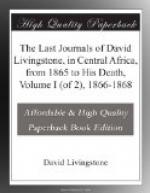11th June, 1868.—Crossed the Mbereze, ten yards broad and thigh deep, ascending a range of low hills of hardened sandstone, covered, as the country generally is, with forest. Our course S.E. and S.S.E. Then descended into a densely-wooded valley, having a rivulet four yards wide and knee deep. Buffaloes and elephants very numerous.
12th June, 1868.—We crossed the Mbereze again twice; then a very deep narrow rivulet, and stopped at another in a mass of trees, where we spend the night, and killing an ox remained next day to eat it. When at Kanengwa a small party of men came past, shouting as if they had done something of importance: on going to them, I found that two of them carried a lion slung to a pole. It was a small maneless variety, called “the lion of Nyassi,” or long grass. It had killed a man and they killed it. They had its mouth carefully strapped, and the paws tied across its chest, and were taking it to Casembe. Nyassi means long grass, such as towers overhead, and is as thick in the stalk as a goose-quill; and is erroneously applied to Nyassa. Other lions—Thambwe, Karamo, Simba, are said to stand 5 feet high, and some higher: this seemed about 3 feet high, but it was too dark to measure it.
13th June, 1868.—The Arabs distinguish the Suaheli, or Arabs of mixed African blood, by the absence of beard and whiskers: these are usually small and stunted in the Suaheli.
Birds, as the Drongo shrike, and a bird very like the grey linnet, with a thick reddish bill, assemble in very large flocks now that it is winter, and continue thus till November, or period of the rains.
A very minute bee goes into the common small holes in wormeaten wood to make a comb and lay its eggs, with a supply of honey. There are seven or eight honey-bees of small size in this country.
A sphex may be seen to make holes in the ground, placing stupified insects in them with her eggs; another species watches when she goes off to get more insects, and every now and then goes in too to lay her eggs, I suppose without any labour: there does not appear to be any enmity between them. We remained a day to buy food for the party, and eat our ox.
14th June, 1868.—March over well-wooded highlands with dolomite rocks cropping out and trees all covered with lichens, the watershed then changed to the south.
15th June, 1868.—Yery cold in mornings now (43 deg.). Found Moenempanda, Casembe’s brother, on the Luluputa, a stream twenty yards wide and flowing west. The Moenempanda visited by the Portuguese was grandfather to this one, and not at the same spot; it is useless to put down the names of chiefs as indicating geographical positions, for the name is often continued, but at a spot far distant from the dwelling of the original possessor. A slave tried to break out of his slave-stick, and actually broke half an inch of tough iron with his fingers; the end stuck in the wood, or he would have freed himself.




